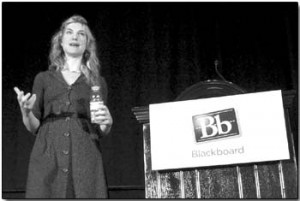Well, this is deflating.  Here I have been extolling the teaching benefits of various widespread technologies, many of which are not particularly new, in the grand scheme of things (Blogs, about 10 years old. Video games, at least 25 years old). I have also been accused of not giving traditional universities or professors credit for being great innovators.
Here I have been extolling the teaching benefits of various widespread technologies, many of which are not particularly new, in the grand scheme of things (Blogs, about 10 years old. Video games, at least 25 years old). I have also been accused of not giving traditional universities or professors credit for being great innovators.
Many of them are. But these survey results would seem to indicate that the vast majority are not. They use their Learning Management Software (at least the gradebooks and syllabus features) but when it comes to anything else, they don’t bother.
Many folks on Twitter asked “How do we change that?”
Here’s some thoughts.
“The first step may be teaching the teachers how to use those tools” said @Hutchirish on Twitter.
I actually disagree. I think that the beauty of the current generation of social media is that anyone who’s motivated can pick up the basics of these tools in a couple of minutes. Remember, we’re talking about a highly educated, intelligent group of people here. There are 70 million blogs out there and 120,000 are being created every day. There are 500 million members of Facebook and several million on Twitter, and almost 190 million households will soon have videogame players. How many of these millions of people had to be explicitly instructed in the use of these technologies?
I don’t think professors aren’t using these technologies because they don’t know how. The reality is a little more complicated.
@Chanders writes, “You’re prepping to teach a class you’ve never taught . You’ve a month. What should you do: learn social software or class content?”
I actually think this is a real question, not a rhetorical one; and it’s a much broader problem with university teaching in general. I think it’s far more important to know how to teach than to necessarily know all the content the course is supposed to put across, because teaching is not supposed to be about feeding forward information.
Whereas pre-K-12 teachers, in order to be certified, receive at least nominal instruction in the practice of instruction itself, from what I understand it’s possible to get a PhD or an MFA or even just be a graduate student on the path to a degree, and get stuck in front of classes full of undergraduates with zero instruction in how to teach. Nor, from everything I understand about how the professoriat works, are professors generally subject to any kind of organized professional development on teaching practice. I don’t remember my parents going to weekend workshops on how to conduct writing seminars at Louisiana State University.
Nor generally do they get rewarded directly for how well their students perform or master information (although they may catch flak via student evaluations if their students don’t LIKE them). In fact all of the work they do to prepare for their classes, if they are lucky enough to be tenure track, is considered to be taking away from their real work of publishing and scholarship. (If they are adjuncts, the work they do to prepare for their classes is likely to be done on the train or during downtime on their shifts at their second job!)
Consider that this system, which doesn’t prepare professors to teach, doesn’t particularly reward them for teaching well, and prefers that they do other things rather than getting better at teaching on their own time–consider the arrogance of the fact that this system considers itself the best kind of teaching there is. Once you get through 12 years of being taught by folks trained and certified in actual pedagogy, only then you are deemed worthy of studying with real scholars–ie, people who know only the content of their own field. And it is held to be self-evident, by the professors themselves, that whatever they come up with to do in their classrooms with no oversight or instruction about how to do it–is a far, far better learning experience then some stupid research-based learning software or some dumb award-winning video lecture by the most fascinating and brilliant expert in the world. Do you prefer wandering into a random regional theater and sitting through an original play by the local Corky St. Clair or Netflixing a five-star film of your choice?
So, the reason most profs don’t use blogs, or wikis, or Google Docs, or videoconferencing or video games or even clickers in their lectures, is probably because they don’t see why they should, they’re not being supported to learn why they should and they wouldn’t be rewarded for it even if they did. It’s an exceptional minority who will endeavor to innovate and be excellent under those circumstances.
If you want to change that you probably have to change the circumstances.


